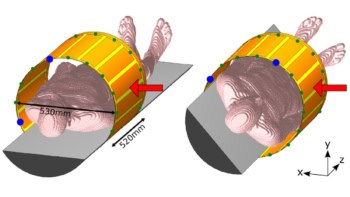
Early detection and treatment of lung cancer are essential to reduce the mortality rate. According to the National Lung Screening Trial, screening high-risk patients with low-dose chest CT can reduce deaths from lung cancer compared with screening with chest X-rays. However, although low-dose CT delivers about one quarter the radiation dose of standard CT, its biologic effects remain unclear.
To investigate whether exposure to low-dose CT could increase the risk of radiation-induced cancers, a Japanese research team compared the number of DNA double-strand breaks and chromosome aberrations in peripheral blood lymphocytes following low-dose and standard-dose chest CT. They found that the low-dose CT scans used in lung cancer screening did not appear to damage human DNA (Radiology 10.1148/radiol.2020190389)
The study included 209 participants referred for chest CT studies, 107 of whom underwent low-dose CT and 102 who had standard-dose CT. The median effective dose was 1.5 mSv for low-dose CT and 5.0 mSv for standard-dose CT, with blood doses approximately 30% lower after low-dose CT than standard-dose CT. The researchers – from Hiroshima University and Fukushima Medical University – took peripheral blood samples from all participants immediately before and 15 minutes after the CT exam, and analysed blood lymphocytes in the samples.
To count the number of DNA double-strand breaks after CT, the researchers used immunofluorescent staining to visualize γ-H2AX, a marker of DNA double-strand breaks. They counted γ-H2AX foci in blood samples from 101 patients who underwent low-dose CT and 101 who had standard-dose CT. Before scanning, the median number of foci was similar in both groups. After CT, the median number of γ-H2AX foci showed a significant increase in the standard-dose group (from 0.11 to 0.16 foci per cell), while no significant increase was observed in low-dose CT group (from 0.15 to 0.17 foci per cell).
The team also quantified the number of chromosome aberrations, which reflect both the radiation damage and the accuracy of DNA repair, in 95 low-dose CT and 92 standard-dose CT patients. The median numbers of chromosome aberrations before low-dose and standard-dose CT were 6.7 and 7.6 per 1000 metaphases, respectively. After CT, the number of chromosome aberrations per 1000 metaphases was 7.2 in the low-dose group and 9.7 for the standard-dose group.
To confirm this finding that standard-dose CT resulted in greater DNA damage than low-dose CT, the researchers studied 63 individuals who underwent both low- and standard-dose CT. The number of cells collected enabled analysis of γ-H2AX and chromosome aberrations in 57 and 54 participants, respectively.
After low-dose CT, the number of γ-H2AX foci per cell increased from 0.11 to 0.16, while the number of chromosome aberrations per 1000 metaphases grew from 7.1 to 8.0. After standard-dose CT, the number of foci increased from 0.11 to 0.20, and the number of chromosome aberrations increased from 7.8 to 9.2.
“We could clearly detect the increase of DNA damage and chromosome aberrations after standard chest CT,” says senior author Satoshi Tashiro from Hiroshima University. “In contrast, even using these sensitive analyses, we could not detect the biological effects of low-dose CT scans. This suggests that application of low-dose CT for lung cancer screening is justified from a biological point of view.”



